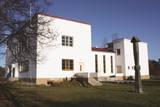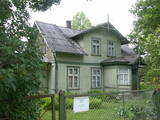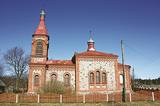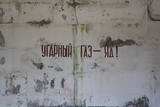| Нo | Название | Описание |
|---|---|---|
|
Комплекс отдыха на северо-западном берегу озера Рушонс, предлагающий ночлег, питание и активный отдых. |
||
|
Название Добеле впервые упоминается в исторических источниках в 1254 году. Добеле было одним из наиболее укрепленных земгальских мест, поэтому в период с 1279 по 1289 гг. пережило шесть нападений немецких крестоносцев. В 1289 году земгальцы вынуждены были отступить. В 1335 году завоеватели на месте земгальского замка приступили к строительству нового, каменного замка. На противоположном левом берегу Берзе начался образовываться посад торговцев и ремесленников. Город сильно пострадал во время Северной войны и последующей эпидемии чумы. Важное событие в хозяйственной жизни города произошло в 1927 году, когда была построена железнодорожная линия Лиепая - Глудас. После Второй мировой войны в Добеле и окрестности города пришли советские военные, которые построили один из крупнейших танковых полигонов СССР «Добеле-2». Сейчас путешествующим по Добеле предлагается интересный выбор посещаемых объектов. |
||
|
Brīvdienu mājas "Korķi” apkārtnes priežu mežā ir izveidota Jāņtarpiņu taka. Ideāla vieta aktīviem sēnotājiem un ogotājiem. Savukārt saules un jūras cienītāji pa šo taku 5-10 minūšu gājienā nonāks Vitrupes pludmalē, kur varēs baudīt sauļošanās un peldēšanās priekus.
|
||
|
Хозяйство «Лациши» находится в Галгауской волости, на юго-западе от Гулбене. Специализация хозяйства, одного из крупнейших в северо-восточной части Видземе – зерновые (577 га), рапс (295 га) и семеноводство разных трав. Второе направления деятельности хозяйства – это разведение крупного рогатого скота молочной породы (около 100 коров), мясной породы и молодняка. Создано интересное помещение для обсуждений и презентаций, объединенное с коровником (за работой в коровнике можно наблюдать через большие оконные стекла). Активно включаются в освоение проектов ЕС. По предворительной договоренности возможен осмотр хозяйства и обмен опытом. |
||
|
Для изначального ознакомления с латышскими ремеслами посетите этнографический музей под октрытым небом в Риге, где искусные мастера продемонстрируют вам традиционные навыки. На выезде из Риги посетите производителя березового сока и вина, который расскажет и покажет, как добывается и сохраняется березовый сок. Вы также сможете попробовать сок. Затем отправляйтесь в местность, связанную со старинными историческими легендами. Посетите музей знаменитого латышского героя – Лачплесиса, чтобы посмотреть на Пояс Лиелварде, в который вплетен рассказ при использовании старинных секретных символов. В Кокнесе прокатитесь на корабле викингов вокруг живописных развалин Кокнесского замка. Затем посетите ферму, где выращивают коноплю и произодят традиционное конопляное масло, козью ферму и производителя традиционного домашнего пива. Регион Латгалии славится своими гончарными школами и «черной» керамикой. На своем пути вы посетите несколько мастерских, а также Лудзенский Центр Ремесел, который ознакомит вас с местными традициями. На типичной латгальской ферме испробуйте традиционный ритуал латгальской бани, а также отведайте местную кухню. Затем остановитесь в Аглонской Базилике, которая является местом паломничества. А для радостей желудка посетите Музей Хлеба, ферму, где производят вкусные сыры и другие полезные молочные продукты, а затем и местного производителя травяных чаев, где узнаете немного о том, как быть здоровыми. Вас ждет экскурсия по историческому центру Даугавпилса, впечатляющей крепости 19 века, а затем визит на дроболитейный завод, где находится одна из самых больших и до сих пор действующих дроболитейных башень в Европе. На пути в Ригу посетите впечатляющую Балтийскую жемчужину- Рудальский Дворец. |
||
|
Neliela ziepju un dažādu citu ķermeņa kopšanas produktu darbnīca. Pašu audzētos un saimniecības pļavās ievāktos ārstniecības augus iestrādā ziepēs un skrubjos, gatavo no tiem izvilkumus augu eļļās, kurus iekļauj lūpu balzamos un krēmos. Ziepes tiek vārītas tā, kā to darīja agrāk - no sārma un taukvielām. Apmeklētājiem iespēja ielūkoties “Ezervanna” mazajā darbnīcā, paklausīties stāstā par ziepju vārīšanu, iemēģināt roku un radošumu skrubju gatavošanā vai “pamīcīties” ar ziepju veidojamo masu un pagatavot savu ziepju gabalu. |
||
|
Построен в 1939 году «при содействии своего отечества Латвии и с помощью родственных народов - финнов, эстонцев и венгров». В первое воскресенье августа здесь отмечают праздник Ливов. |
||
|
Mузей Миервалдиса Кемерса –
известному работнику культуры Латвии (1902
1980) – священнику и художнику посвящен
мемориальный музей на улице Дубрес 21.
|
||
|
Die zentrale und auch schönste Straße in Trakai mit bunten Holzhäusern. Eins der seltenen Kenesa-Gebetshäuser der Welt – ein eingeschossiges Holzhaus mit einem bläulichen Dach. |
||
|
Ceļa malā, kas ved uz Kärdla pilsētu, ir zivju pārstrādes veikals, kur iespējams iegādāties Hījumā zvejnieku nozvejotas zivis gan svaigas, gan kūpinātas, kā arī tiek pārdoti Hījumā mazo ražotāju produkti. Zivis iespējams nobaudīt arī turpat uz vietas, veikalā ir kafejnīcas stūrītis, bet vasarā ārpusē ir terase.
|
||
|
Cesvaine was first mentioned in written sources in 1209. For each traveller in Latvia, the town is associated with the family of Baron Woolf, who bought the Cesvaine estate in 1815. Cesvaine experienced the economic boom after establishment of Plavinas Gulbene railway. Town suffered significantly during the World War II. At the end of 2002, the Cesvaine Castle was struck by the tragedy - a fire, which damaged most of the castle. Cesvaine Castle is "recovering" by means of large public, state and local government support and still keeps the status as a significant tourism attraction in a scale of Vidzeme and Latvia. |
||
|
Was mentioned in 1387, where it was called Domesnes. That was the name until the early 20th century. A ledger at the Irbe-Ģipka church states that there were four farms in Kolka in 1770 -- Krogi, Ūši, Vecvagari and Kabriki. In 1844, a school for vergers was established, and Nika Polmanis worked there as a teacher. Kolka's first school was built in 1881, and Livonian Kārlis Bernšteins (1881-1951) worked there for nearly half a century as a teacher. The Dundaga riots that began in 1859 were led by Livonian Nika Šūbergs (1833-1884), the son of the owner of the Sārnasti farm. At the end of the 19th century, there were 392 residents in Kolka, and in 1935, 145 of the 343 residents were Livonians. During the mid-1980s, 13 Livonians spoke their language freely. Kolka is the only coastal Livonian village that continued to develop during the frontier regime of the Soviet Union, because it was the centre of a fishing kolkhoz. The number of residents increased rapidly in the 1950s and 1960s because new homes, a school, a people's centre, a kindergarten and several fish processing factories were built there. Today Kolka has 700 residents and is the largest village along the Livonian coastline. The "Līcis-93" fish processing factory is there, and local fishermen and smokers of fish work in the village. The Kūolka Livonian Centre and the Livonian ensemble Laula operate there, as well. The Ūši farm offers tastings of Livonian foods. |
||
|
The former building of the State Bank is at A. Pormaļa Street 11 in the centre of Jēkabpils. The 1931 building was erected in the style of Classicism, and the interior has been preserved to this very day. The Jēkabpils branch of the SEB Bank occupies the building at this time. |
||
|
Vāldamõ – a residential building that is yellow and has natural roofing materials. It was built as a new farm at the beginning of the last century. Virgo is the next homestead to the North from Vāldamõ, and it was established as a new farm in the 1920s. The house (1930) features interesting wood carvings. Next to the North is Fīlmaņi, which has a building that appears antique, but was built in the early 20th century as a single roof. Silkalni is the homestead that we find if we turn to the right toward Pitrags at the crossroads. The yellow building was built around 1906 as a single room. Norpiedagi is to the South from Silkalni – a brown and larger house than the previous one. The home was built around 1906 as a one-room granary by the active Liv public activist and boat builder Diriķis Volganskis (1884-1968). His son, Edgars Valgamā, who was also a Liv cultural activist and worked as a pastor in Finland, was born here. Anduļi can be found at the aforementioned crossroads. This is one of the largest old farms in the village, and it is owned by the village elder. The history of the homestead was first recorded in 1680, when it was called Kūkiņi. The homestead includes a residential building (c. 1909), a threshing barn (1905), a granary (mid-19th century), and a smokehouse made of a boat that was cut in two. Under the part of the threshing barn which is on the back of the dune, there is the medieval, so-called Plague cemetery. Žoki is a homestead that is on the other side of the road from Anduļi. The building that is there now was built on the foundation of an older one. In the mid-19th century, Žoki was home to the first reading school for Liv children from the seashore villages of the Dundaga region. Liv Nika Polmanis (1823-1903) worked there as a teacher. Next to the North of Žoki is the Tilmači homestead, with several buildings that were built in the late 19th and early 20th century – a brown residential building, a stable and part of a granary. When the residential building was restored, the owner found a board reading "1825. Kurlyandskaya gubernya." The seven historical homesteads and buildings were at one time considered for listing on the UNESCO list of world heritage. |
||
|
The Staldzene Zenith Missile Brigade used a large territory and a number of major buildings. Some of these are now privately owned, and a fish smoking facility has been installed at one of them.
|
||
|
This is one of the most interesting protected territories in the city of Rīga, and its aim is to protect coastline biotopes – dune and coastal meadows and the birds and plants which are found there (among them, 29% of the species of orchids). There is a marked information trail with a bird-watching tower. This is the only outdoor viewing tower in Latvia that has been adapted for the needs of people in wheelchairs.
|
||
|
Sarkanās klintis savu vārdu ieguvušas pateicoties sarkanajiem iežiem. Tieši sarkanā ir mīlestības krāsa, tāpēc sarkanās klintis ir romatiska pastaigas vieta mīlniekiem. Smilšakmens klintīs redzamas plaisas, kas sašķeļ sarkanīgos iežus, radot neparastu dabas mākslas darbu. To virsma ir diezgan izrobota, kas veido klintīs nelielas alas un nišas. Sarkanajās klintīs ir arī daudz dažādu avotiņu. Pazīstamākais no tiem ir Rūcamavots. Tam ir šāds nosaukums, jo tas, nākot ārā no zemes, izdod nelielu rūkoņu. |
||
|
Liellopu izsoļu nams ir vienīgais liellopu izsoļu nams Baltijā. Izsoles tiek rīkotas gaļas šķirņu jaunlopiem - buļļiem un telēm vecumā līdz 12 mēnešiem, regulāri - divas reizes mēnesī. Katru mēnesi izsolēs piedalās vairāk kā 2000 Latvijā audzēti jaunlopi. |
||
|
The café and guest house, located in the centre of Ventspils, is housed by a classical 19th century wooden building that used to belong to the Kupfer family and is listed as European Heritage. Latvian cuisine: farmer's breakfast, oat or semolina porridge, potato pancakes. |
||
|
Atrodas Kūrmājas prospekta turpinājumā pie gājēju ietves, kas ved uz jūru. Piemineklis (uzstādīts 1977. g.) simbolizē sievieti, kas gaida mājās pārnākam savu vīrieti. |
||

























